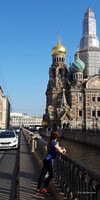The Savior on Spilled Blood or the Church of the Resurrection of Christ is one of the most beautiful and majestic churches in Russia, located in the center of St. Petersburg on the embankment of the Griboyedov Canal.
The full name of the church is the Cathedral in the name of the Resurrection of Christ on the Blood, which is popularly called the Savior on the Blood.
The church is both an Orthodox church, a memorial monument and a museum of Russian architecture of the late 19th and early 20th centuries.
The Savior on Spilled Blood was erected in memory of the fact that on this place (now the embankment of the Griboyedov Canal, formerly the Catherine Canal) on the afternoon of March 1 (13 new style), 1881, as a result of an attempt (explosions of two bombs), Emperor Alexander II was fatally wounded. The wounded tsar was put on a sleigh and taken to the Winter Palace, where he died an hour and a half later.
Thus, the cathedral is a memorial to the Tsar-Liberator, and the expression "on the Blood" reflects a historical event and indicates the tragedy and the shed blood of the tsar.
The place of the emperor's fatal wound immediately acquired a special, sacred significance. Already in the evening of March 1, the site was fenced with a wooden fence, next to which a sentry was posted.
A temporary small chapel was erected on the site of the assassination attempt.
The successor of Alexander II - his son Alexander III, at the initiative of the city Duma, decided to perpetuate the memory of the deceased tsar and build a memorial temple on the site of the regicide, which was to be created based on the Moscow and Yaroslavl architecture of the late 16-17 centuries and so that the memorial place-the place of the fatal wound of the tsar on the embankment, was located inside the cathedral.
As before, today the Church of the Savior on Spilled Blood approaches directly to the Griboyedov Canal and captures part of the embankment. Which makes it even more attractive and indissolubly integrated with the channel.
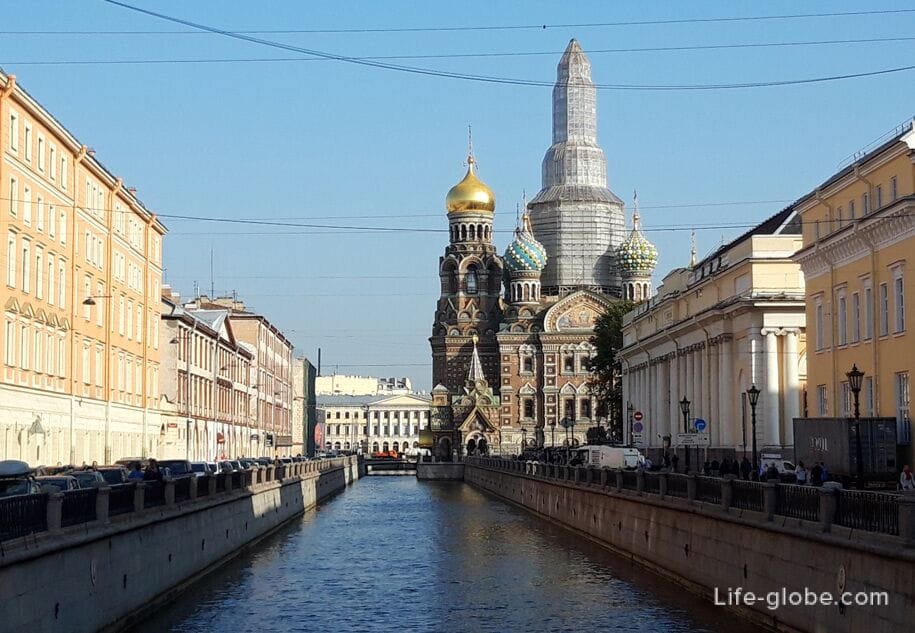

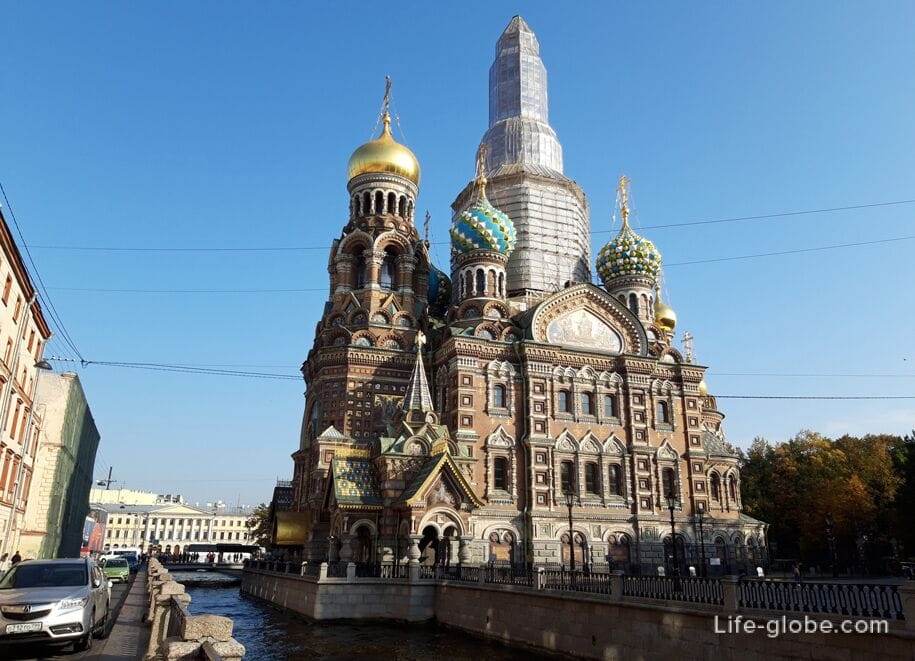
The construction of the church took place from October 6, 1883 to 1907, according to the project of the architect Alfred Alexandrovich Parland in collaboration with the rector of the Trinity-Sergius Desert, Archimandrite Ignatius (Malyshev), who proposed to name the church "Resurrection of Christ". Russian Russian ecclesiastical architecture The architect of the cathedral, having creatively reworked the techniques of Russian church architecture of Moscow churches of the 17th century, received the so-called style of "Russian Eclecticism".
Before the construction of the temple began, part of the cast-iron grating of the canal embankment, which the wounded tsar held on to, granite slabs and part of the cobblestone pavement, stained with the blood of Alexander II, were removed, placed in boxes and transferred to storage as relics in the chapel on Konyushennaya Square.
The construction of the temple was carried out: partly at the expense of the royal family, partly at the expense of public donations, and most of the funds were allocated by the main treasury.
During the construction, all the advanced achievements of science and technology of that time were applied: a lightning protection system was made, the crosses of the central chapter and the bell tower served as lightning rods; the original air heating system was arranged in the room, developed in the office of engineer S. Ya. Timokhovich; the lighting of the temple was electric.
The cathedral was consecrated on August 19 (September 1, new style), 1907, by Metropolitan Anthony of St. Petersburg and Ladoga in the presence of the Imperial couple, Grand dukes and princesses, ministers of the Court and the highest clergy.
Initially, the temple was not designed for mass attendance. It did not baptize, marry, or have a funeral service. Only services and memorial services dedicated to the memory of Emperor Alexander II were held in the church.
The temple was maintained by the state.
After the revolution, the church became a cathedral for a while. In 1930, it was closed and the question of its demolition was raised. But these plans did not take place. The building housed various kinds of warehouses (vegetable shops, workshops).
During the war (the siege of Leningrad), the cathedral was damaged, but not destroyed. The cathedral also housed a morgue. After the war, the temple was given to the Small Opera House, which arranged a warehouse of scenery in the walls of the temple.
In Soviet times, many of the cathedral's valuables were lost (looted, destroyed).
In 1968, the cathedral was taken under the protection of the State Inspectorate for the Protection of Monuments under the Main Architectural and Planning Department. After the cathedral began to restore.
Today, the Savior on Spilled Blood has the status of a museum (small tours of the cathedral are held for everyone), and services are also held in the cathedral.
The nine-domed church stands out for its Russian architecture with its multicolored appearance, external mosaic compositions, marble decorations and an abundance of architectural elements.
The outer plinth of the temple is lined with dark and light gray Valaam granite, brought from the island in Lake Ladoga.
Walking through the center of St. Petersburg, it is quite difficult not to notice this temple, because its picturesque composition of "Russian eclecticism" stands out vividly in the classical environment of the nearby buildings and at the same time very harmoniously fits into the appearance of the city, decorating the embankment.
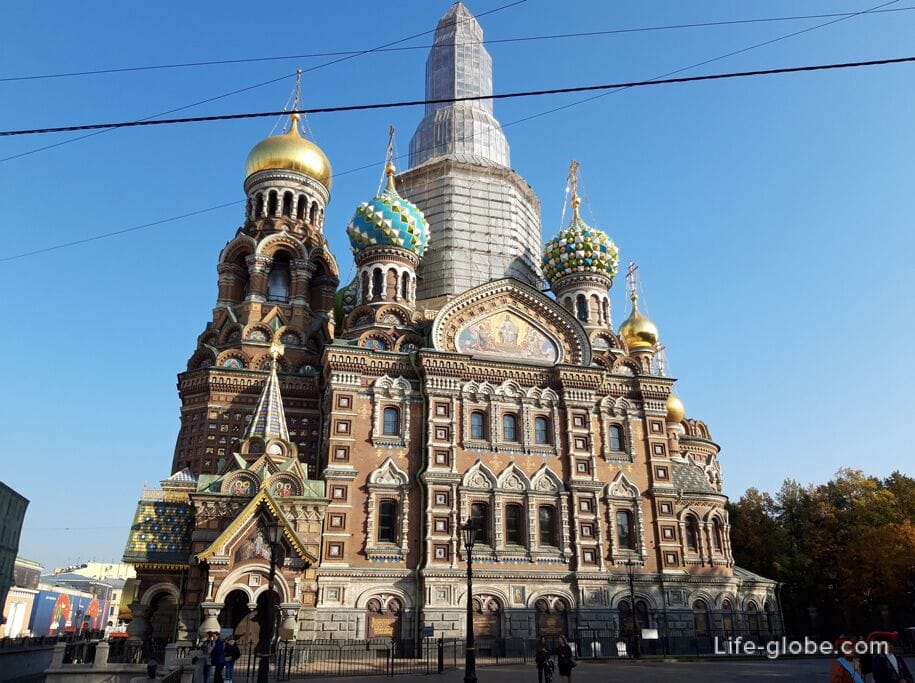

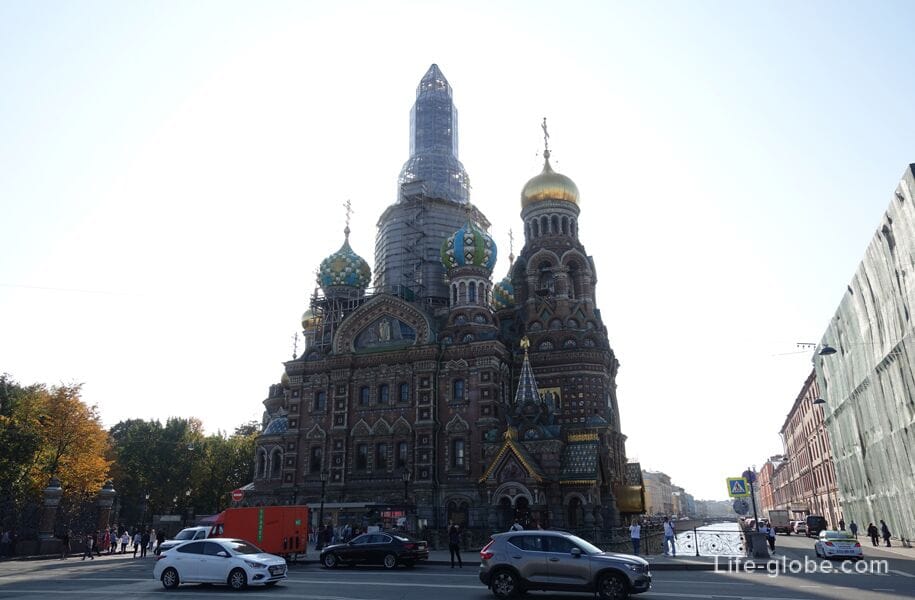
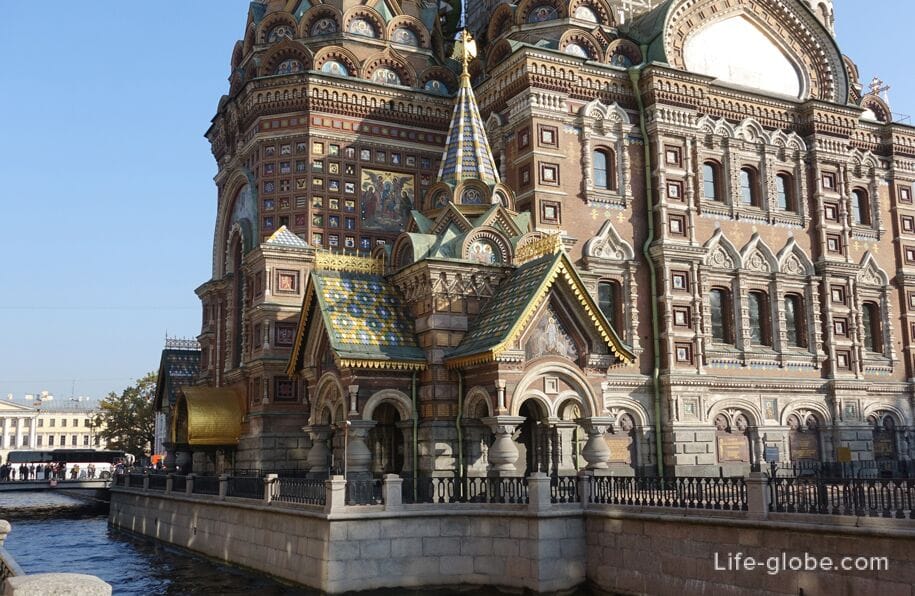
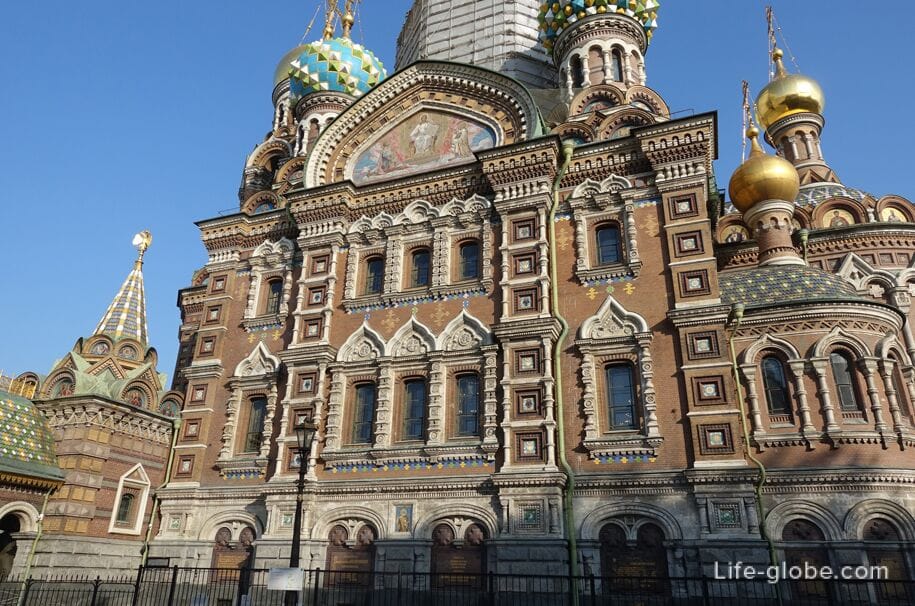
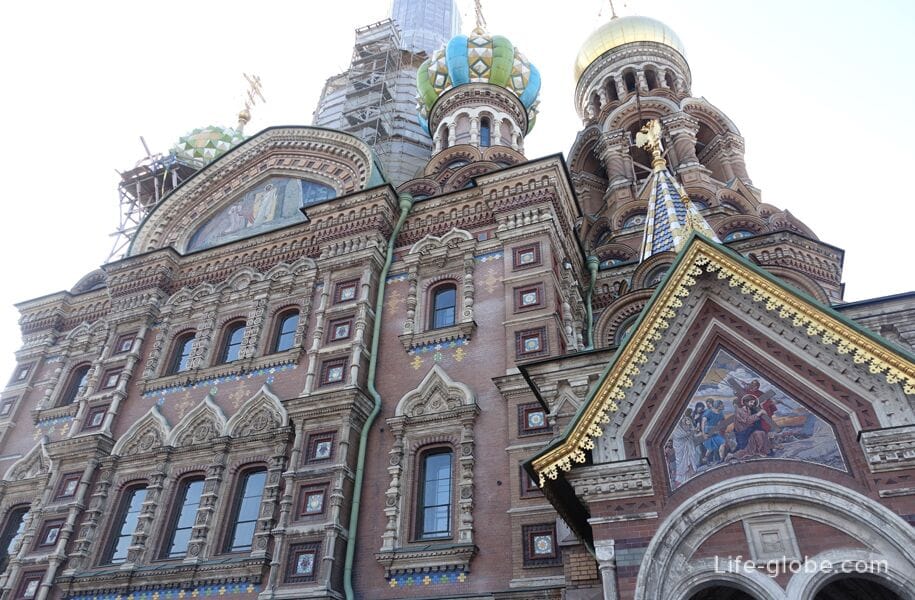
In the western part of the Savior on Spilled Blood (near the Griboyedov Canal), above the place of the fatal wound of Alexander II, there is a bell tower.
The entire lower part of the bell tower is occupied by mosaic coats of arms of the provinces, regions and cities of the Russians, whose inhabitants participated in the creation of the temple.
Under the gilded canopy is a relief marble cross with a mosaic crucifix of the Savior-an allegory of the sacrificial feat of the tsar-martyr.
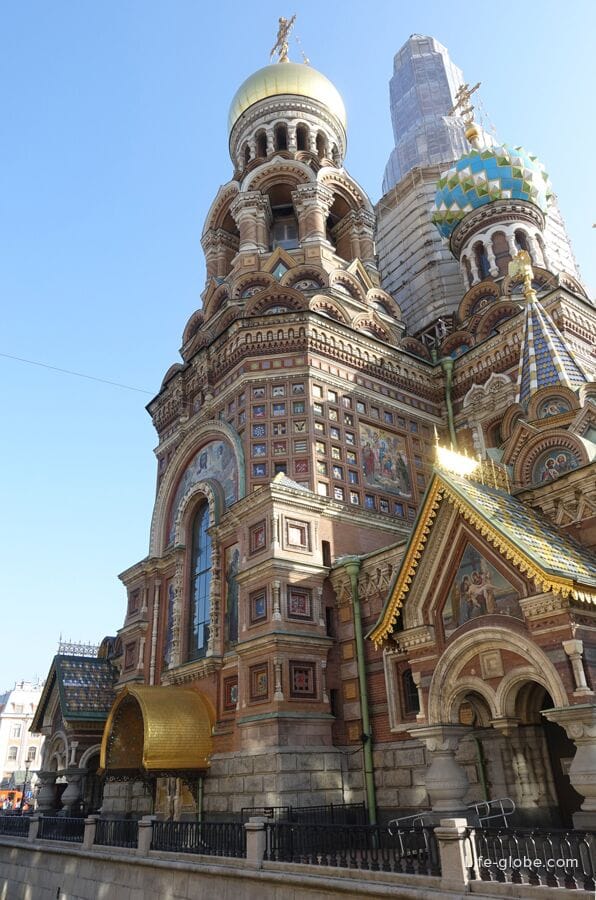
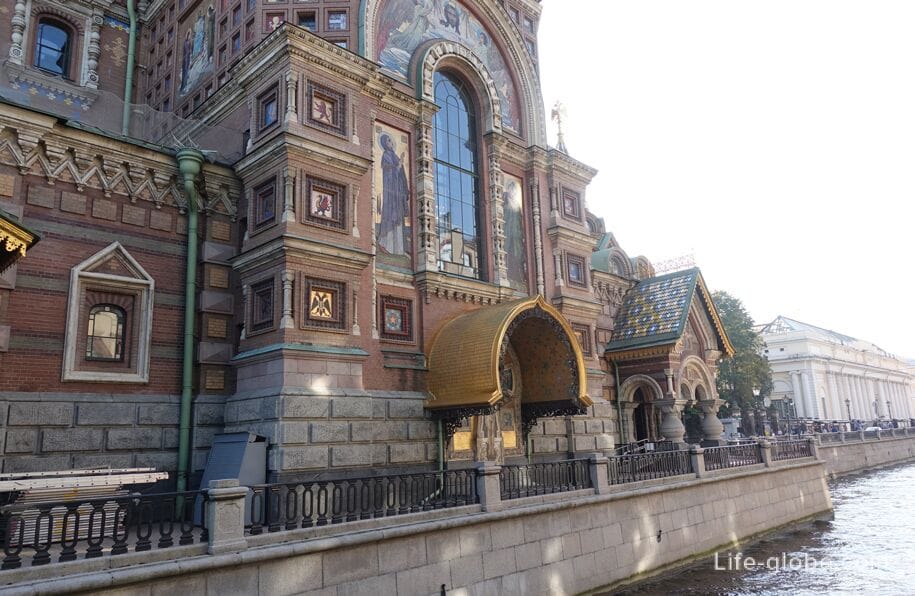
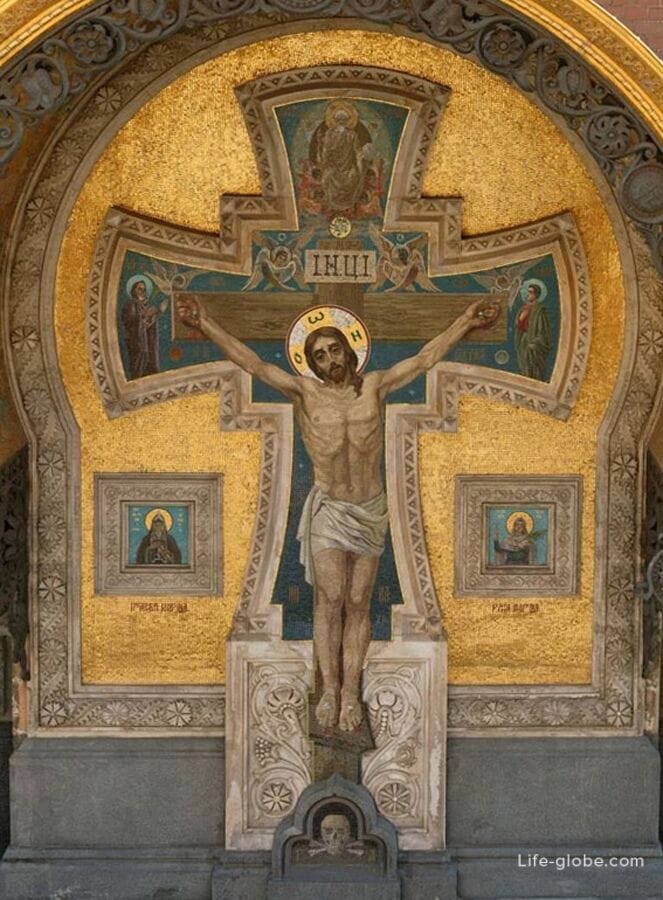
In the eastern part of the cathedral (facing theThree semicircular apses are crowned with small gilded domes.

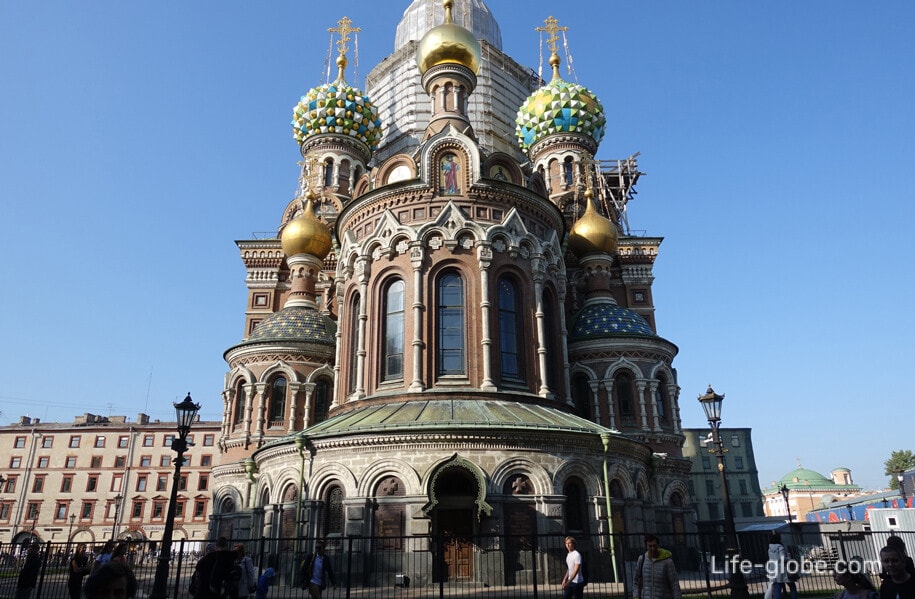
On the southern outer wall of the cathedral (in the lower part), you can see traces of bullets and shell fragments that hit the cathedral during the war.
This piece of wall was not specially restored, it was left as a memory of the war, so that everyone could see the destructive power of human wars and not repeat the terrible mistakes of humanity.
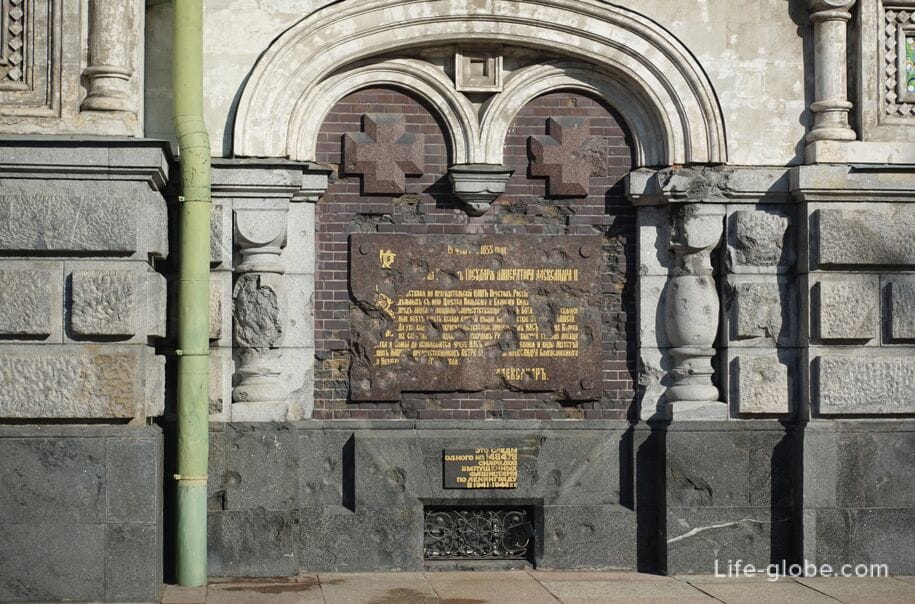
Interior of the Savior on Spilled Blood
The interior of the Savior on Spilled Blood is richly decorated with Russian ornamental stone and Italian marbles, and the mosaic ensemble, which is the dominant space of the interior, was created according to the projects of artists of the turn of the 19th and 20th centuries and is considered one of the largest collections of monumental mosaics in Europe.
The mosaic compositions in the cathedral are divided by various ornaments, of which there are about 80 in the church.
The overall direction of the mosaic ensemble of the cathedral belongs to the architect Parland.
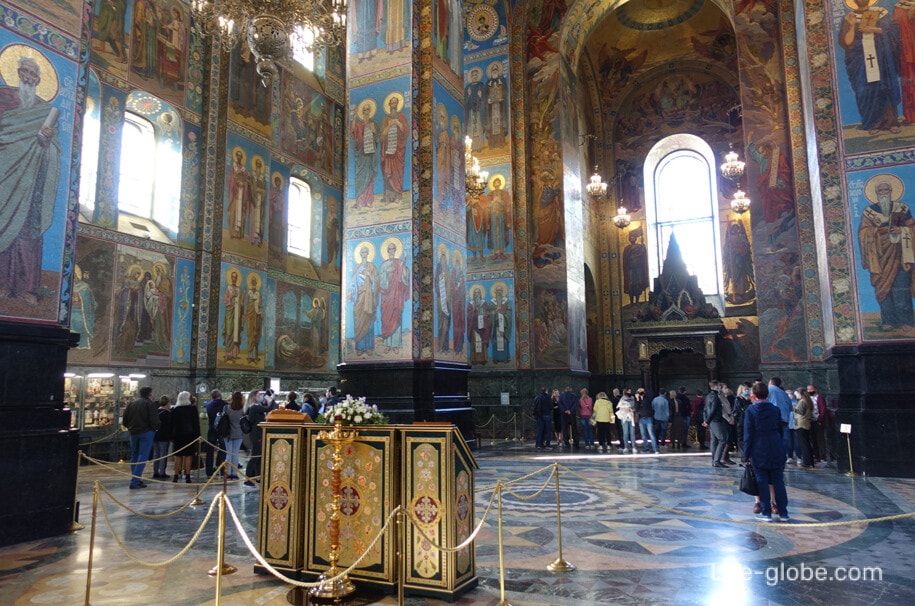
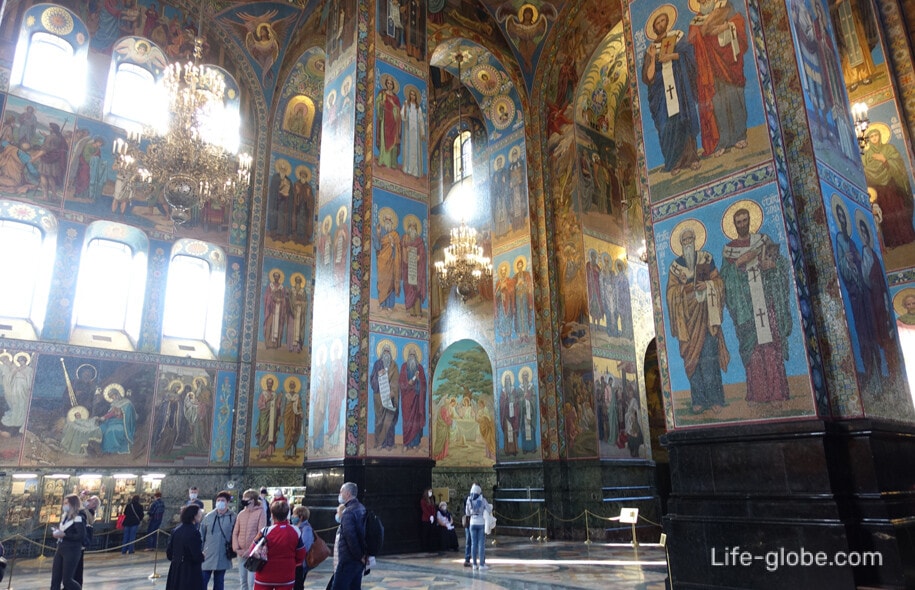
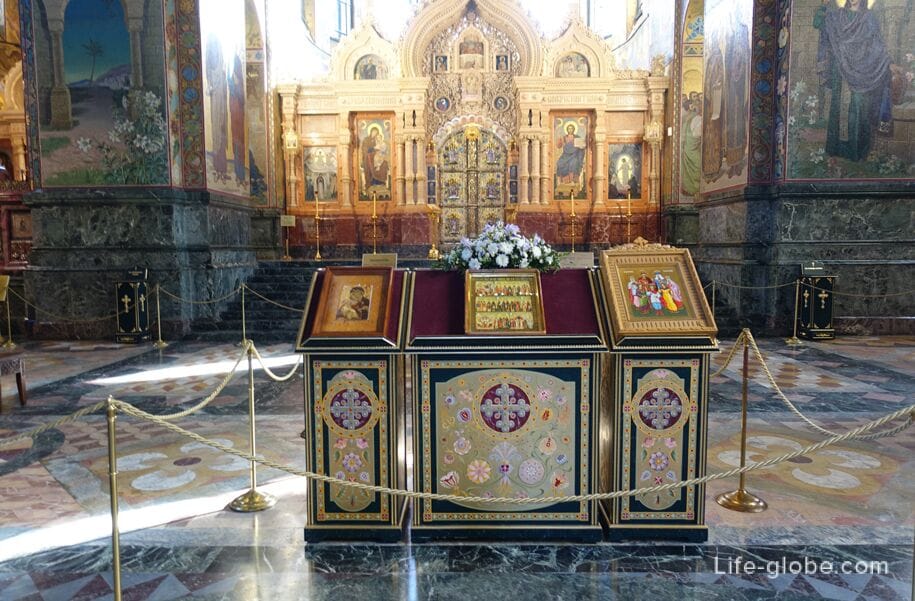

Of particular importance in the interior of the temple is its western part (the side near the Griboyedov Canal), which is a memorial complex and includes the place of the fatal wound of Alexander II on the embankment.
The place of the king's wound in the temple is represented by a stone tent canopy. The canopy in this case is an artistically designed canopy on columns, symbolizing the protection or protection of the place.
Under the shade, a part of the pavement, which was laid after the construction of the temple, and a link of the cast-iron grating of the canal embankment, on which the wounded king leaned, are preserved, stained with the blood of the king.
The drawing of the canopy was made by the architect A. Parland in the image of the royal place-the Manomakh Throne of Ivan the Terrible in the Assumption Cathedral of the Moscow Kremlin.
To create the canopy, we used the best samples of domestic ornamental stones-rhodonite and various types of jasper.
Only 4 jasper columns and part of the rhodonite balustrade have survived to this day. The upper part is a model that is made of plaster and tinted with natural stone.

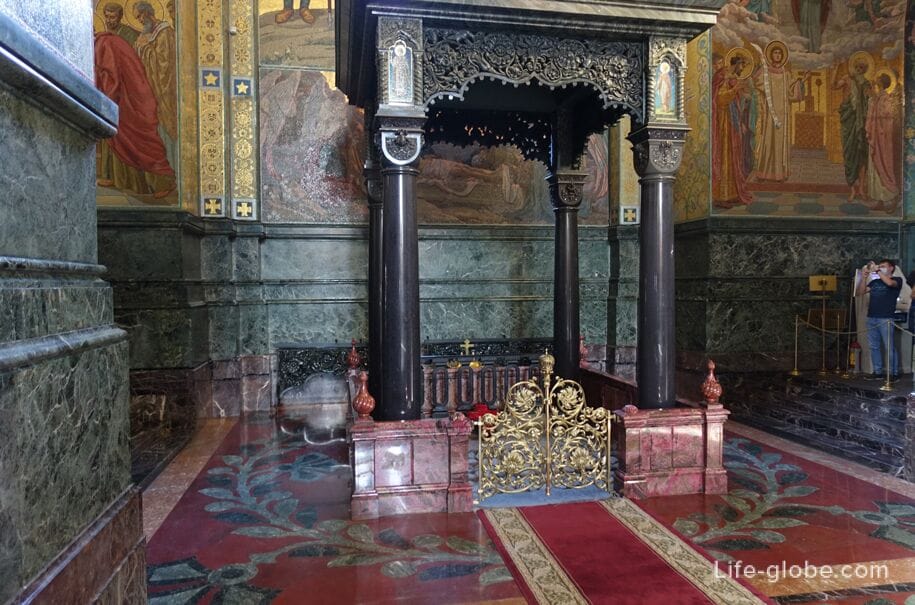
The western (memorial) part of the cathedral is decorated with mosaics telling about the teachings, the crucifixion and the resurrection of Jesus Christ. Here a peculiar parallel is drawn between the tragic violent death of Emperor Alexander II and the death of Jesus Christ.
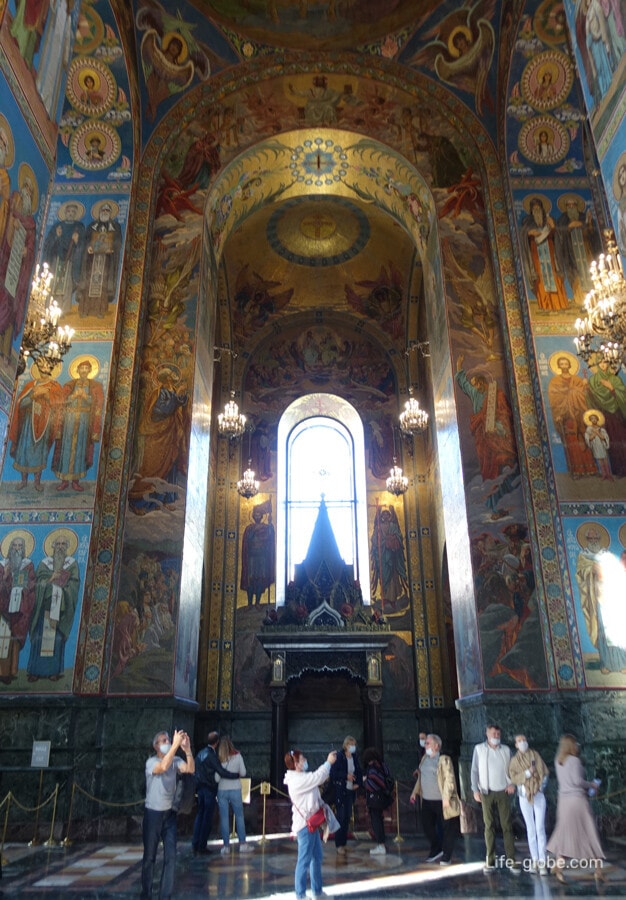
The building of the temple is stretched along the east-west axis for 60 meters. The total area of the temple hall is 886 square meters. The basis of the structure is 8 pillars (pylons), which divide the interior of the temple into three naves (three longitudinal parts).
The central nave is wider and at the intersection with the cross section in the plan forms a cross, above the center of which rises the dome.
In the ceiling of the central dome, a mosaic depicts Christ Pantocrator or the Almighty against a blue sky studded with stars, his hands raised in a blessing gesture, and on his chest an open gospel with the greeting phrase "Peace be upon you".
The mosaic is located at an altitude of 45 meters and was designed by the icon painter Nikolai Kharlamov.
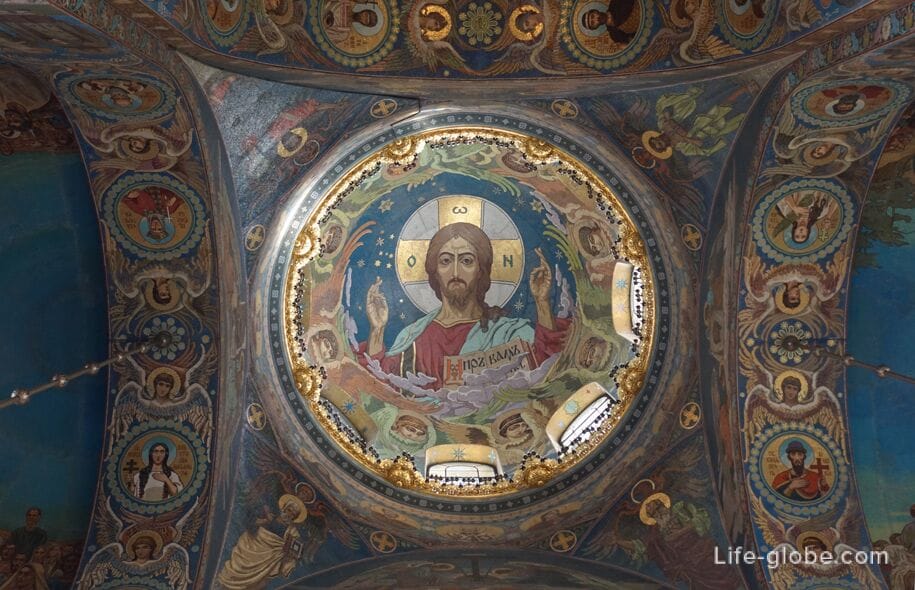
The entire space of the temple is symbolically divided into two zones - heavenly and earthly.
The altar apses belong to the heavenly part, the dome and vaults in the eastern part, and the walls and pylons belong to the earthly part.
The walls, pylons, and vaults are completely finished with a mosaic of smalt - small cubes of opaque colored glass. The total area of the mosaic ensemble of the facade and interior of the temple is 7,000 square meters.
Stone mosaics adorn the floor of the temple.

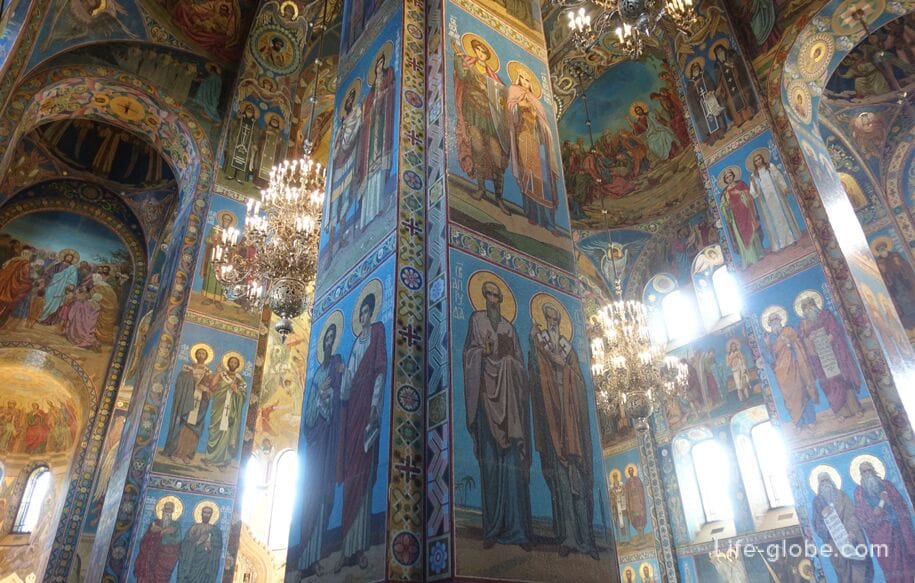
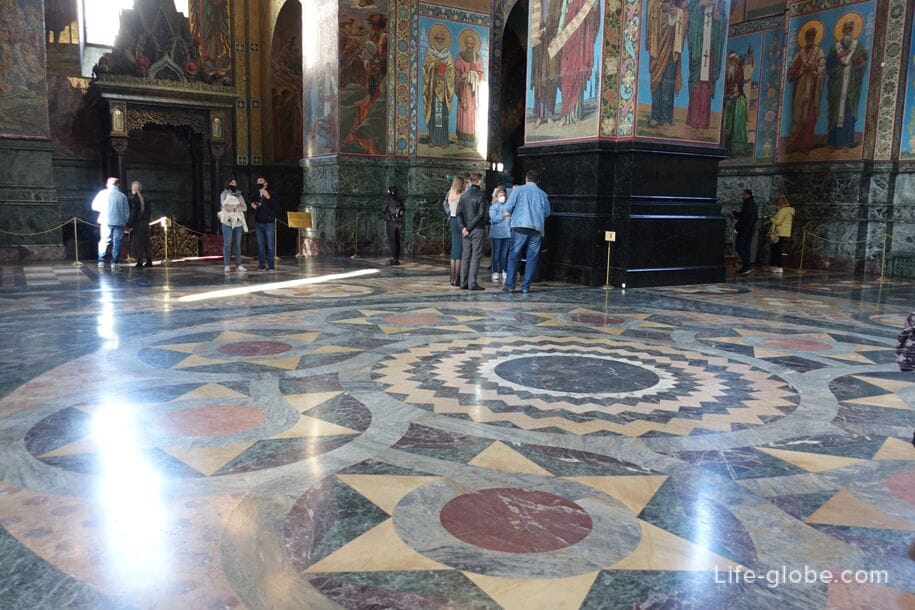
Mosaics telling about the earthly life of Jesus Christ cover the southern and northern walls of the temple with a solid carpet. All the compositions on the walls of the temple, from the life of Christ, are combined into a single story about the holy scripture.
Such a system of decoration of churches allows you to fully reveal the essence of Christian teaching in vivid visual images. The system is borrowed from Byzantine ecclesiastical art.
Scenes of the Annunciation are placed on the pre-altar pylons. Mary receives the news that she will give birth to a child - the son of the most high God.
The narrative continues on the south wall. There are compositions here: the Nativity of Christ, the appearance of angels to people, the baptism of Christ.
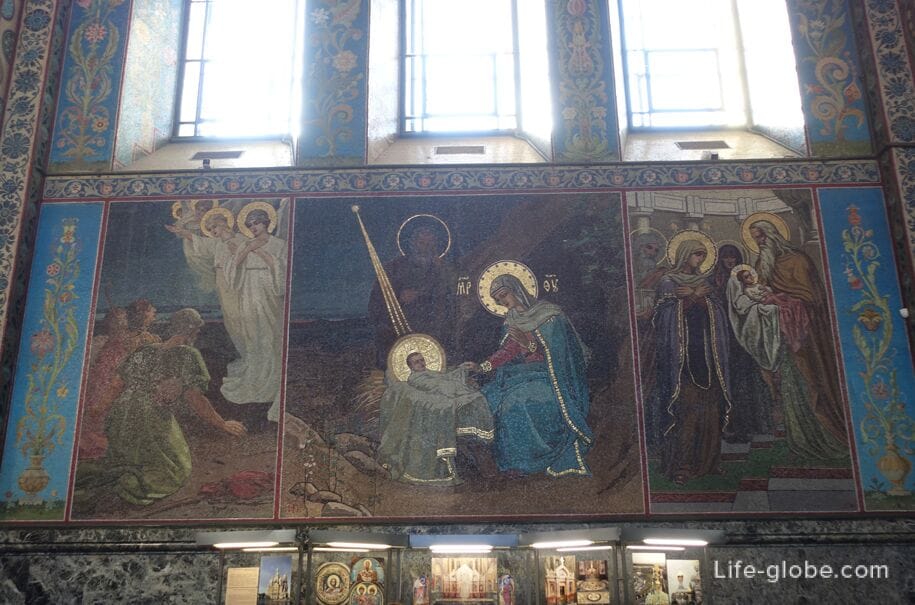
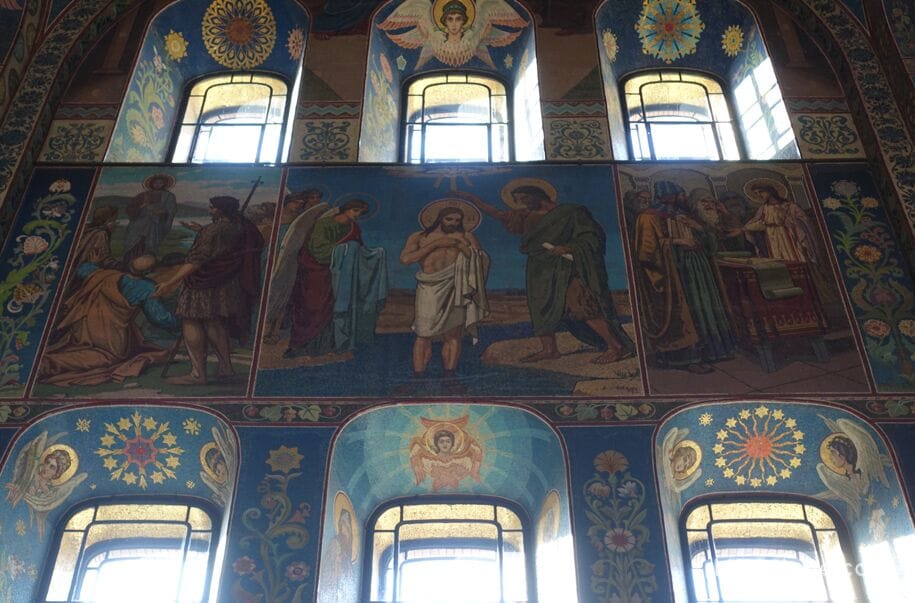
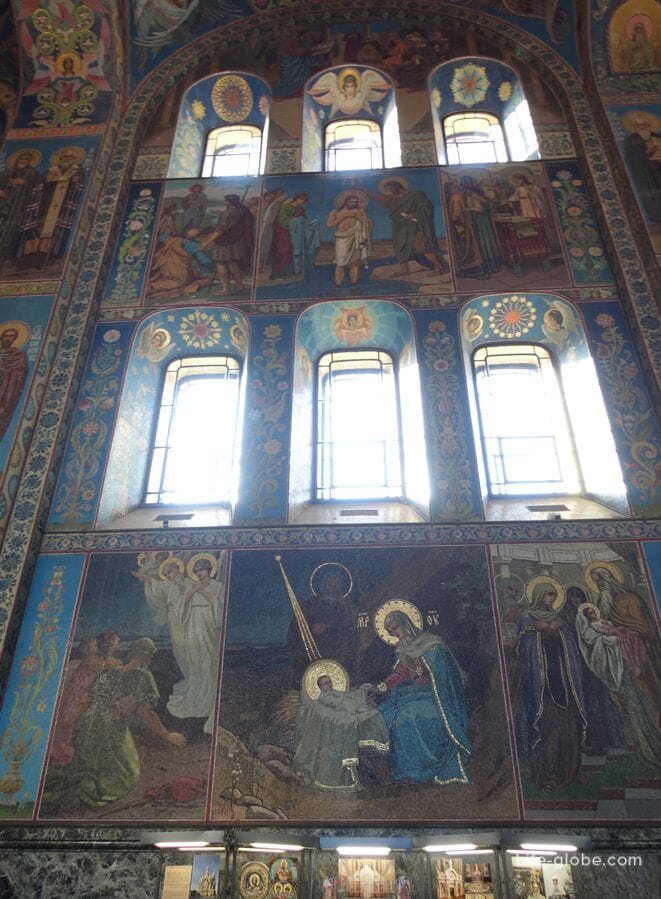
At the age of 30, Christ was baptized and the earthly ministry of Jesus Christ begins, which is described by the compositions on the northern wall of the temple. It depicts the miracles of healing, and the calming of the storm, which is described by the mosaic "Walking on the Waters", created by the project of the artist Andrey Ryabushkin.
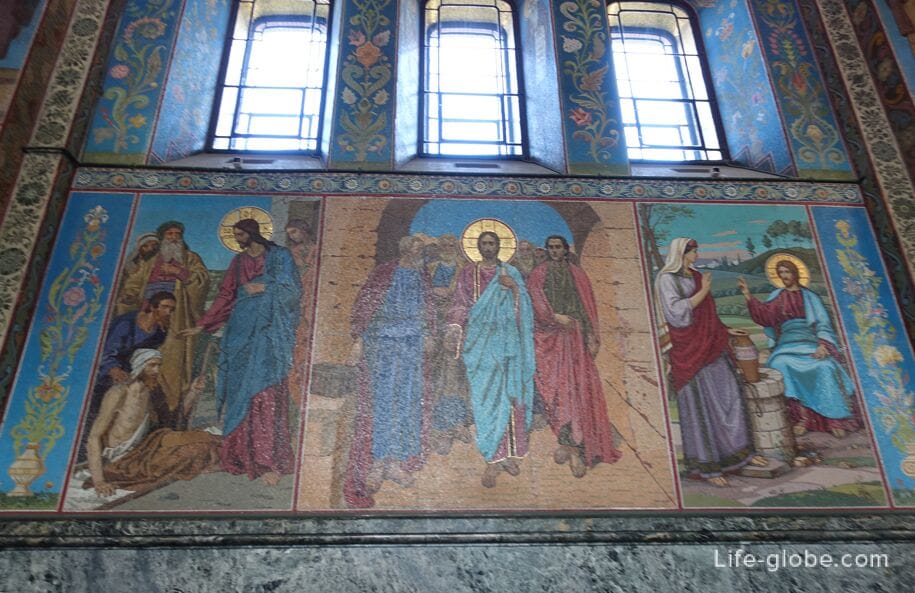
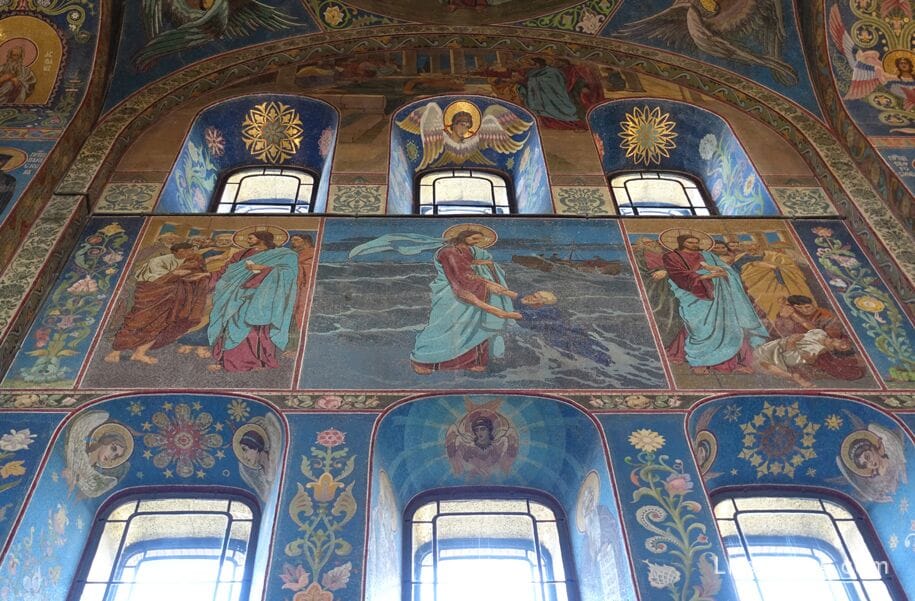
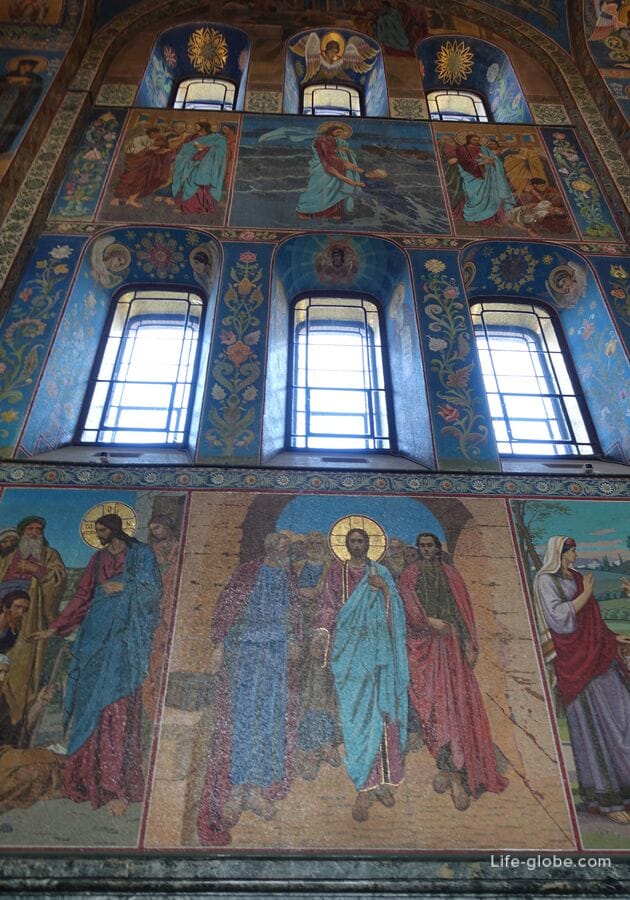
The mosaics in the church were made by students of the Frolov Brothers ' school.
The Frolov brothers have mastered the Venetian or reverse method of setting mosaics from smalt. The reverse mosaic set method was five times faster and, consequently, five times cheaper than the usual direct set method.
The artist created a simplified pictorial original with a well-developed outline, from which the tracing paper was removed in a mirror image. The master pasted pieces of smalt on the canvas tracing paper, without seeing the front side. The assembled mosaic was placed in a wooden frame and filled with cement with iron reinforcement. After drying, the tracing paper was washed off, and mosaic blocks measuring a meter and a half, on iron pins, were attached to the wall. The seams of the fragments were laid with smalt in the direct method of typing, as a result of which whitish horizontal stripes can be seen on the mosaics in the cathedral, which mark the borders of the mosaic blocks.
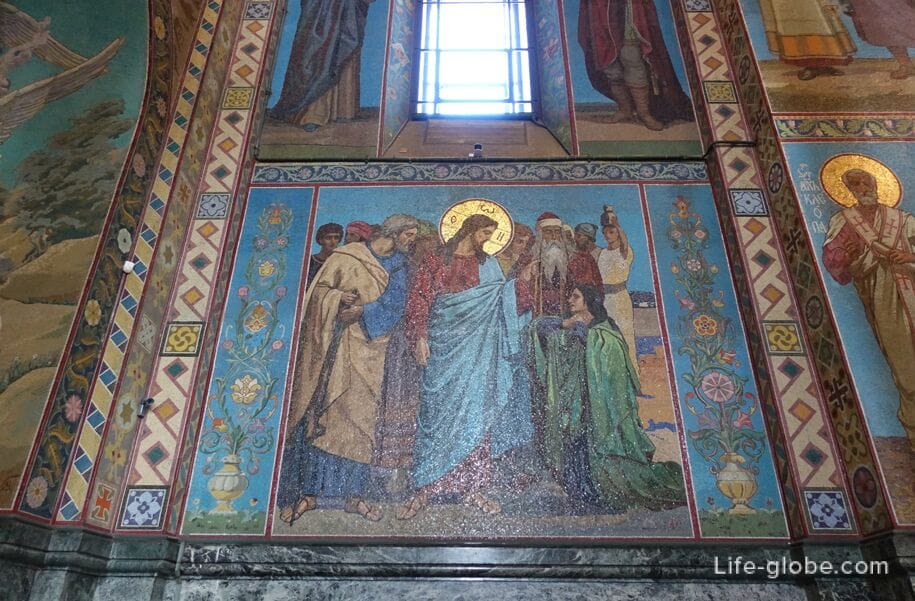
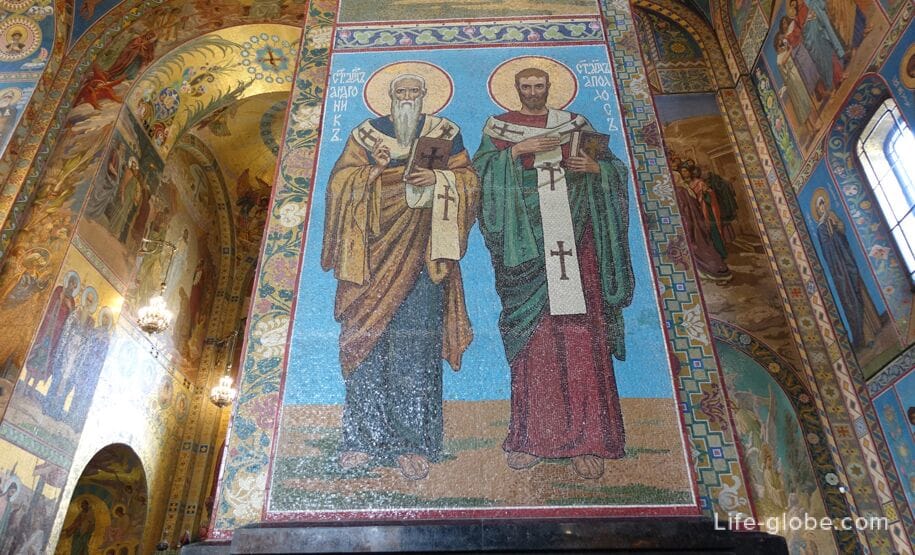
The southern and northern kiosks in the temple are a kind of showcases for displaying icons that cover part of the iconostasis.
Each kiosk was designed for 8 icons. In the center was a mosaic icon, the other seven were traditional.
Kiots were the place for the most revered icons. The icons were removed and lost during the Soviet era, and now there are black-and-white photographs in their place. Only two mosaic icons have been preserved, one in each of the southern and northern kyots.
The kiosks are made by the masters of the Yekaterinburg lapidary and Kolyvan grinding factories from pink rhodonite, Korgon porphyry, Revnevskaya, Orsk and Aushkul jasper.
The selection of the stone for the kiots was not accidental, it was of a memorial nature. The sarcophagus for the Emperor Alexander II was made of Revnevskaya jasper (green color). And from rodinite (pink color) - a sarcophagus for the wife of the emperor-Maria Alexandrovna. Both sarcophagi can now be seen in Peter and Paul Cathedral (Peter and Paul Fortress), which is located on Zayachy Island in St. Petersburg.
The central mosaic icon of the northern kiot is called "Holy Prince Alexander Nevsky" and it depicts Alexander Nevsky, who was considered the patron saint of Alexander II.
The mosaic is made according to the sketch of M. N. Nesterov in the mosaic department of the Academy of Arts by direct method of a set of smalt, in each piece of which several color shades are connected. Thanks to this, this mosaic differs from the wall mosaics and has deeper color schemes and can be attributed to the Art Nouveau style, which came into fashion at the beginning of the 20th century in Russia.
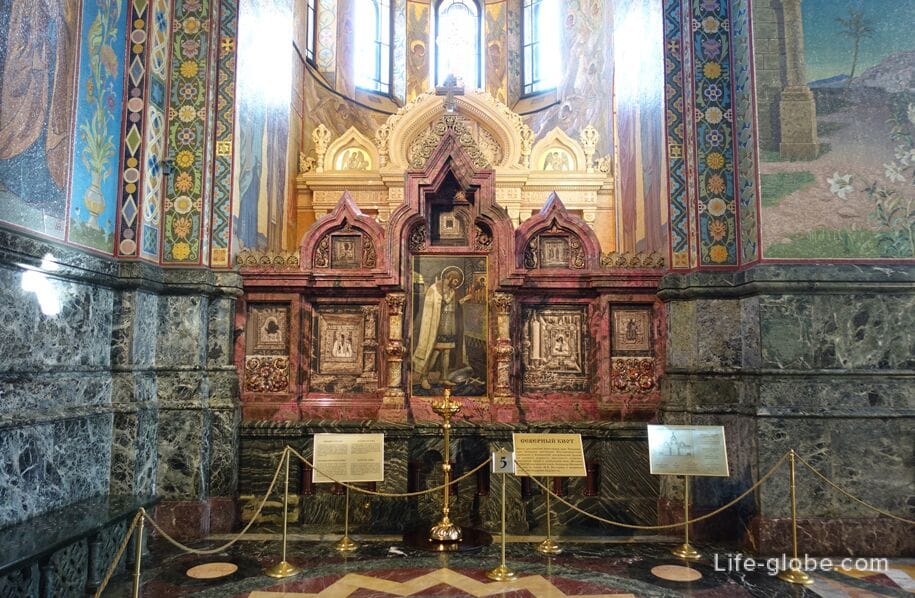

The central mosaic icon of the southern kyot "Resurrection of Christ". Jesus Christ stands at a stone that has been rolled away from the cave, and on top of it is an inscription - " Where are you the sting of death...". The icon was created by Mikhail Nesterov.


Iconostasis of the temple The Savior on Spilled Blood, located in the center between the pillars, is a barrier separating the altar from the central part of the temple.
The iconostasis was made in Genoa by the company "Novi" of multicolored Italian marbles. The lower part is brown, the middle part is pink, and the upper part is light yellow marble.
The low three-part iconostasis, like in ancient Russian churches, was designed by Parland.
In the center of the iconostasis is the Royal Gate. The historic royal gate was lost, then recreated by restorers and re-installed in 2012.
The main images of the iconostasis are the image of Jesus Christ in the form of the emperor sitting on the throne, and the Virgin Mary, who gently bent over the little Jesus.
On the right side of the icon of Jesus Christ is the icon "Descent into Hell" - in the Byzantine tradition, this is how the Resurrection of Jesus Christ is depicted. In the second century AD, the apocryphal gospel of Nicodemus becomes known, which tells how Jesus Christ descends into hell after his forefathers Adam and Eve. The icon depicts the dark darkness of the abyss, in the center of Jesus Christ, surrounded by a bluish halo. Jesus holds out his hands to the kneeling Adam and Eve. This story has a deep meaning-the resurrection of Christ gives hope for the resurrection of the entire human race.
The far left icon - "Ascension" - on the 40th day, Jesus Christ ascended to heaven. Below on the ground, the Virgin Mary is depicted standing, next to her two angels, and above-Jesus Christ ascends into the sky.
Mikhail Nesterov worked on the icons "Descent into Hell" and "Ascension".
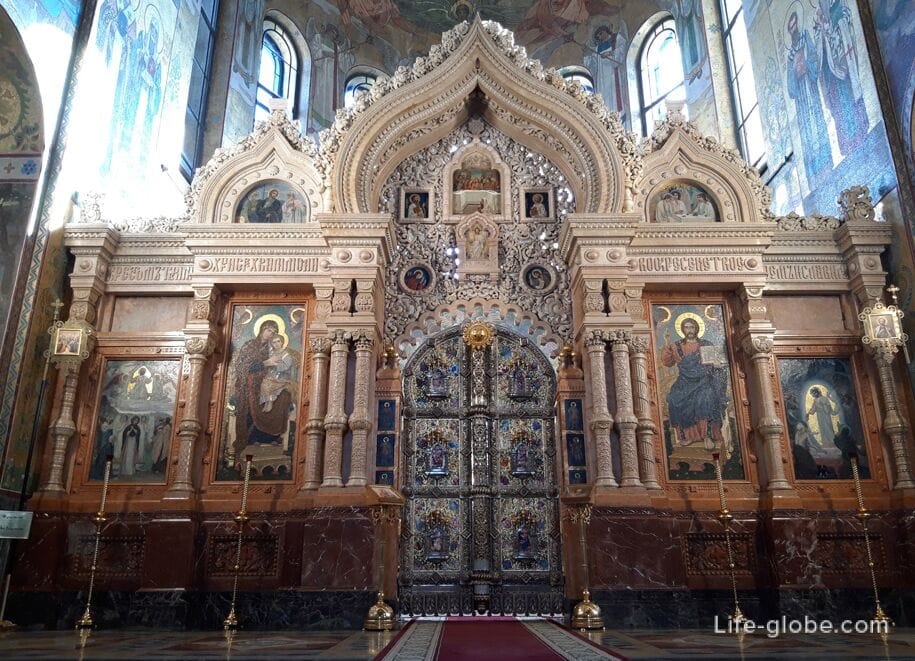
On the vaults of the central apse there is a mosaic "The Savior in Glory", which was designed by the artist Nikolai Kharlamov.
Christ is represented in the radiance of the divine light. The bluish oval signifies the universe. In the center of the universe, Christ sits on thrones. He is surrounded by a heavenly host.
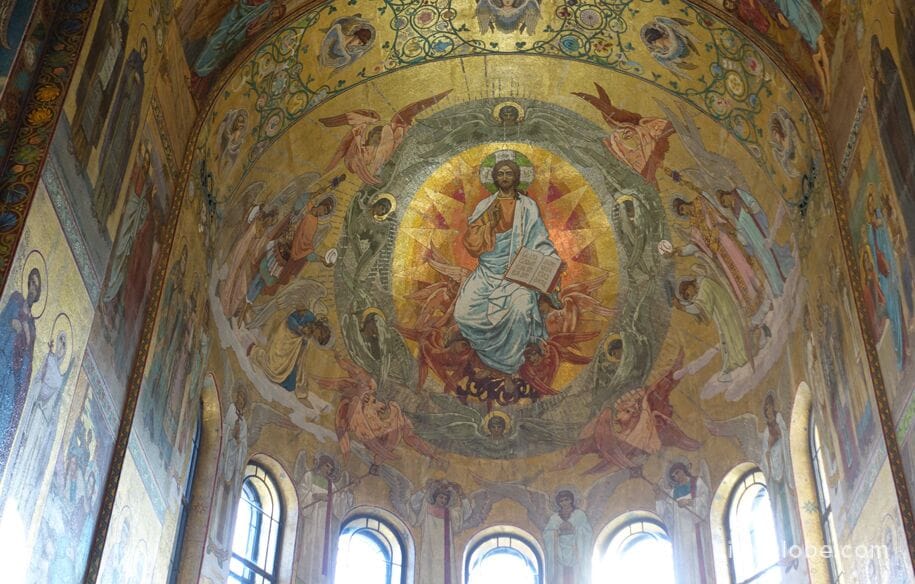

Along the lower parts of the walls of the temple stretch stone benches, which were part of the ventilation and heating system.
In the basement there were two boilers and eight heaters. Warm air passed through the openwork grilles of the benches and thus the heating of the temple was carried out.
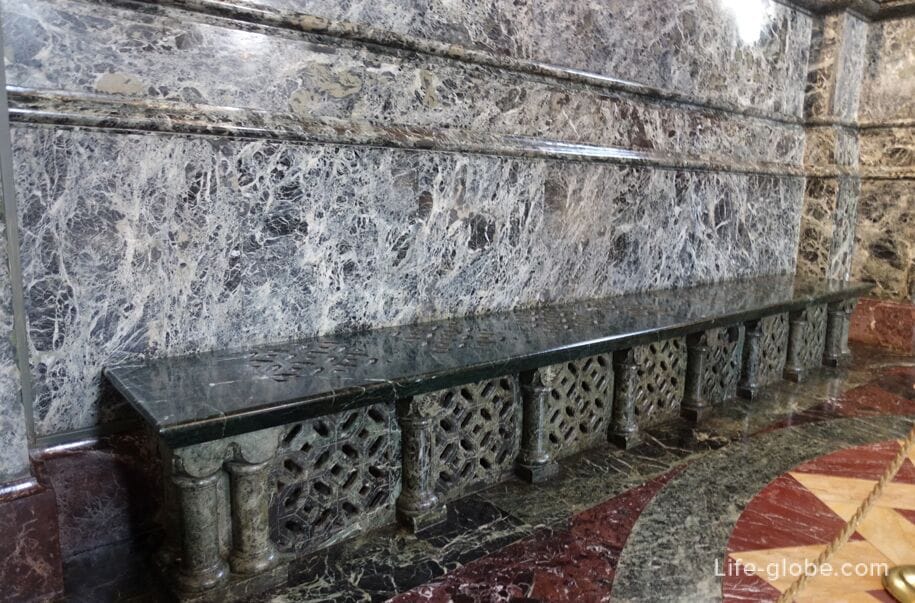
Practical information
The Church of the Resurrection of Christ (Spas na Spilled Blood) is a memorial and museum, part of the state museum-monument "St. Isaac's Cathedral".
Services are also held in the church.
A visit to the cathedral is possible for a fee. Tickets can be purchased at the ticket offices located near the cathedral or purchased in advance-on the official website of the museum.
The cathedral offers guided tours that last about 30 minutes.
You can visit the cathedral for free during the services.
We recommend that you check the opening hours of the cathedral, the time of services and the cost of tickets immediately before visiting.
The museum's website: cathedral.ru.
Website of the Cathedral of the Resurrection of Christ: spas.spb.
Address of the Cathedral of the Resurrection of Christ: Griboyedov Canal embankment, 2B.
The Cathedral of the Resurrection of Christ can also be visited with a guided tour
Next to the Savior on Spilled Blood, at the address: embankment of the Griboyedov Canal 2A letter L, there is a chapel in the name of the Iveron Icon of the Motherof God , which together with the church forms a single architectural ensemble and in which the museum is now located.
In addition, the state museum-monument "St. Isaac's Cathedral" also includes: St. Isaac's Cathedral and the colonnade of St. Isaac's Cathedral - an observation deck.
All accommodation facilities in St. Petersburg, including in the city center and near the Savior on Spilled Blood, can be viewed and booked here




